Death row lawyer: 'If I throw in the towel, a client dies'
updated 4:10 PM EST, Fri March 7, 2014
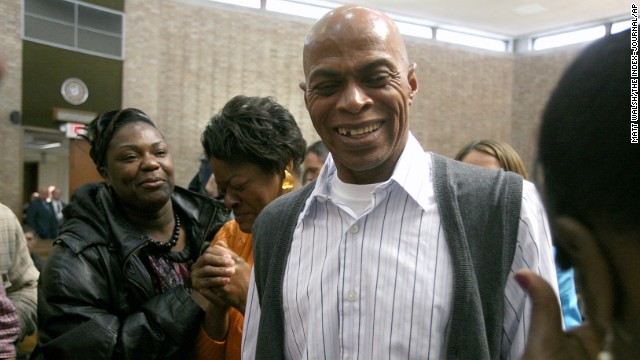 Imprisoned more than half his life for a rape and murder conviction, 53-year-old Edward Lee Elmore, center, celebrates his 2012 release in Greenwood, South Carolina. Appellate lawyers Diana Holt and John Blume uncovered information suggesting that evidence was planted or hidden from defense attorneys. Elmore had been sentenced to death three times for the 1982 rape and murder of 75-year-old Dorothy Edwards, a wealthy Greenwood widow. Elmore had no alibi at the time of the killing.
Imprisoned more than half his life for a rape and murder conviction, 53-year-old Edward Lee Elmore, center, celebrates his 2012 release in Greenwood, South Carolina. Appellate lawyers Diana Holt and John Blume uncovered information suggesting that evidence was planted or hidden from defense attorneys. Elmore had been sentenced to death three times for the 1982 rape and murder of 75-year-old Dorothy Edwards, a wealthy Greenwood widow. Elmore had no alibi at the time of the killing.
For more, watch "Death Row Stories" on CNN at 9 p.m. ET on Sunday.
 In January 1982, Edwards' longtime friend and neighbor Jimmy Holloway let himself into her house after noticing newspapers piling up in the driveway. Holloway, a Greenwood city councilman, called police and told them he had found Edwards' body. He also pointed out Elmore, a semi-literate handyman, as a possible suspect.
In January 1982, Edwards' longtime friend and neighbor Jimmy Holloway let himself into her house after noticing newspapers piling up in the driveway. Holloway, a Greenwood city councilman, called police and told them he had found Edwards' body. He also pointed out Elmore, a semi-literate handyman, as a possible suspect.
 Edwards, who was living alone at the time, had hired Elmore the month before her death for odd jobs around the house. Prosecutors accused Elmore of raping Edwards and beating her to death.
Edwards, who was living alone at the time, had hired Elmore the month before her death for odd jobs around the house. Prosecutors accused Elmore of raping Edwards and beating her to death.
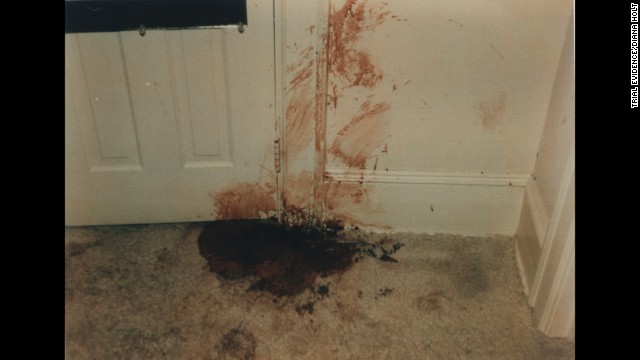 Holloway said he found her bloodied and battered body stuffed in this bedroom closet. Prosecutors said Elmore forced his way into the house through the back door to commit a robbery. An attack occurred in the kitchen, where Edwards suffered a blow so powerful that a denture plate flew out of her mouth, according to testimony.
Holloway said he found her bloodied and battered body stuffed in this bedroom closet. Prosecutors said Elmore forced his way into the house through the back door to commit a robbery. An attack occurred in the kitchen, where Edwards suffered a blow so powerful that a denture plate flew out of her mouth, according to testimony.
 Holloway said this coffee pot was on when he entered the house. It was set to turn on at 6 a.m., suggesting that Edwards was killed after the clock was set and before it turned on. An expert for the defense later testified that Edwards was more likely killed in the afternoon.
Holloway said this coffee pot was on when he entered the house. It was set to turn on at 6 a.m., suggesting that Edwards was killed after the clock was set and before it turned on. An expert for the defense later testified that Edwards was more likely killed in the afternoon.
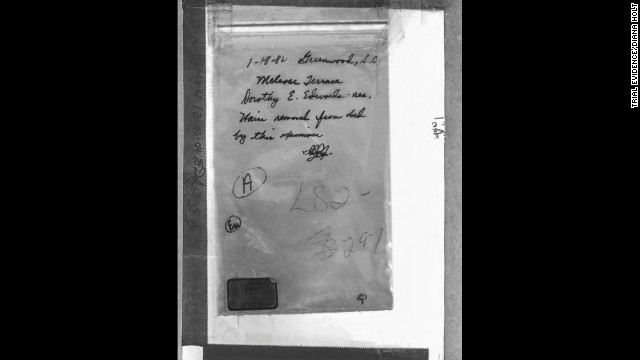 The most damning evidence, according to prosecutors, were these hairs found in Edwards' bed. But Elmore's team found the evidence suspicious because it was not packaged and labeled in the same way as other evidence in the home.
The most damning evidence, according to prosecutors, were these hairs found in Edwards' bed. But Elmore's team found the evidence suspicious because it was not packaged and labeled in the same way as other evidence in the home.
 Police collected head and pubic hairs from Elmore and stored them in this evidence bag. Elmore's team conceded that they belonged to him but said they were collected from him after his arrest and not from the crime scene. To bolster their theory, they pointed out that investigators did not take crime scene photos of the hairs on the bed or package the hairs like the rest of the evidence found at the crime scene.
Police collected head and pubic hairs from Elmore and stored them in this evidence bag. Elmore's team conceded that they belonged to him but said they were collected from him after his arrest and not from the crime scene. To bolster their theory, they pointed out that investigators did not take crime scene photos of the hairs on the bed or package the hairs like the rest of the evidence found at the crime scene.
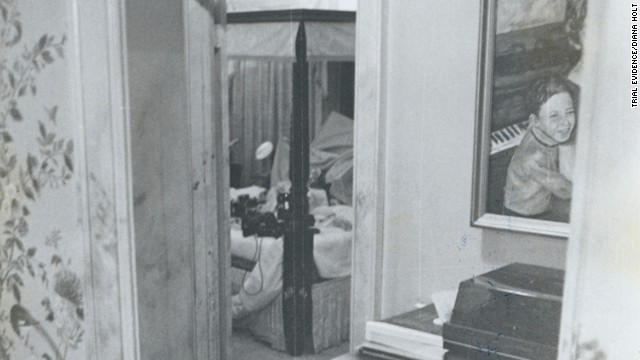 Elmore's team says this photo of the bed where Edwards was raped supports the claim that pubic hairs were never there. They said investigators would not place equipment on the bed, and they would have taken evidence pictures.
Elmore's team says this photo of the bed where Edwards was raped supports the claim that pubic hairs were never there. They said investigators would not place equipment on the bed, and they would have taken evidence pictures.
 This police list suggests that key evidence was lost or hidden. Item "T" included "fibers" and "hairs" collected from Edwards' body but never introduced as trial evidence. More than a decade later, a state investigator found item "T" in the back of a desk drawer. New analysis showed that item T included a "Caucasian hair" that did not belong to Edwards or Elmore.
This police list suggests that key evidence was lost or hidden. Item "T" included "fibers" and "hairs" collected from Edwards' body but never introduced as trial evidence. More than a decade later, a state investigator found item "T" in the back of a desk drawer. New analysis showed that item T included a "Caucasian hair" that did not belong to Edwards or Elmore.
 These are the jeans Elmore was wearing the night prosecutors said Edwards was killed. A state expert told jurors that blood stains matched the victim's blood type. But Elmore's team said a law enforcement agent took them from the crime lab, exposing them to tampering. The scant amount of blood also suggested that they were not worn during the bloody attack, according to defense experts.
These are the jeans Elmore was wearing the night prosecutors said Edwards was killed. A state expert told jurors that blood stains matched the victim's blood type. But Elmore's team said a law enforcement agent took them from the crime lab, exposing them to tampering. The scant amount of blood also suggested that they were not worn during the bloody attack, according to defense experts.
 Elmore's fellow inmate James Gilliam said jail officials offered to "look after" Gilliam in exchange for incriminating testimony. Gilliam told jurors that Elmore confessed to killing Edwards. He later told Elmore's lawyers that he had lied.
Elmore's fellow inmate James Gilliam said jail officials offered to "look after" Gilliam in exchange for incriminating testimony. Gilliam told jurors that Elmore confessed to killing Edwards. He later told Elmore's lawyers that he had lied.
 Diana Holt was a law student in her mid-30s when she joined the case in 1993, 11 years after the first trial. When Holt first met Elmore in prison, she was surprised that a convicted killer on death row could be "so docile and gentle." As she started reading the trial testimony, Holt couldn't believe her eyes. "All the forensic evidence evaporated under the smallest measure of scrutiny," she said.
Diana Holt was a law student in her mid-30s when she joined the case in 1993, 11 years after the first trial. When Holt first met Elmore in prison, she was surprised that a convicted killer on death row could be "so docile and gentle." As she started reading the trial testimony, Holt couldn't believe her eyes. "All the forensic evidence evaporated under the smallest measure of scrutiny," she said.
 Elmore has maintained his innocence since his arrest. He was locked up for a total of 11,000 days before his release. A plea deal with South Carolina prosecutors allowed him to "maintain his innocence" while pleading guilty to murder. He had a choice, Holt said: potentially spend years awaiting another trial or go free. "Immediate freedom stymied ongoing justice
Elmore has maintained his innocence since his arrest. He was locked up for a total of 11,000 days before his release. A plea deal with South Carolina prosecutors allowed him to "maintain his innocence" while pleading guilty to murder. He had a choice, Holt said: potentially spend years awaiting another trial or go free. "Immediate freedom stymied ongoing justice
(CNN) -- By the time Edward Lee Elmore won his freedom at age 53, he had spent 30 years -- most of them on death row -- imprisoned in South Carolina for a crime he says he did not commit.
Law enforcement planted evidence and prosecutors manipulated facts to cast Elmore as the only suspect in the 1982 murder of 75-year-old Dorothy Edwards, his lawyers claim.
Even with seemingly overwhelming evidence in Elmore's favor, it took nearly two decades to win his release, in what an appeals court called "one of those exceptional cases of 'extreme malfunctions in the state criminal justice systems.' "
 'Are they gonna kill me?'
'Are they gonna kill me?'
 CNN's "Death Row Stories" Promo
CNN's "Death Row Stories" Promo
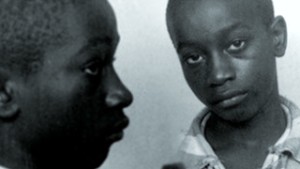 Family wants justice after execution
Family wants justice after execution
 Killer's family: Execution was 'torture'
Killer's family: Execution was 'torture'
 Un-tested drugs used in executions
Un-tested drugs used in executions
His experience raises nearly every issue that shapes America's capital punishment debate: DNA testing, mental retardation, a jailhouse snitch, incompetent defense lawyers, prosecutorial misconduct and "a strong claim of innocence,"
said author Raymond Bonner, who wrote about the case in "Anatomy of Injustice: A Murder Case Gone Wrong."
In other words, a prime example of when "innocence is not enough," Bonner said.
Elmore would probably still be on death row if not for Diana Holt, who began investigating his claims of innocence in 1993. When Holt met Elmore, she was surprised that a convicted killer on death row could be "so docile and gentle."
Two post-conviction review courts rejected Elmore's claims, though one noted that he "may well not be guilty." But Holt never considered giving up.
"If I throw in the towel, a client dies. If I stop working, they stop breathing," Holt said. "Sometimes, I am the first person who ever stuck by them or treated them with respect."
 'Are they gonna kill me?'
'Are they gonna kill me?'  CNN's "Death Row Stories" Promo
CNN's "Death Row Stories" Promo  Family wants justice after execution
Family wants justice after execution  Killer's family: Execution was 'torture'
Killer's family: Execution was 'torture'  Un-tested drugs used in executions
Un-tested drugs used in executions  Imprisoned more than half his life for a rape and murder conviction, 53-year-old Edward Lee Elmore, center, celebrates his 2012 release in Greenwood, South Carolina. Appellate lawyers Diana Holt and John Blume uncovered information suggesting that evidence was planted or hidden from defense attorneys. Elmore had been sentenced to death three times for the 1982 rape and murder of 75-year-old Dorothy Edwards, a wealthy Greenwood widow. Elmore had no alibi at the time of the killing.
Imprisoned more than half his life for a rape and murder conviction, 53-year-old Edward Lee Elmore, center, celebrates his 2012 release in Greenwood, South Carolina. Appellate lawyers Diana Holt and John Blume uncovered information suggesting that evidence was planted or hidden from defense attorneys. Elmore had been sentenced to death three times for the 1982 rape and murder of 75-year-old Dorothy Edwards, a wealthy Greenwood widow. Elmore had no alibi at the time of the killing.  In January 1982, Edwards' longtime friend and neighbor Jimmy Holloway let himself into her house after noticing newspapers piling up in the driveway. Holloway, a Greenwood city councilman, called police and told them he had found Edwards' body. He also pointed out Elmore, a semi-literate handyman, as a possible suspect.
In January 1982, Edwards' longtime friend and neighbor Jimmy Holloway let himself into her house after noticing newspapers piling up in the driveway. Holloway, a Greenwood city councilman, called police and told them he had found Edwards' body. He also pointed out Elmore, a semi-literate handyman, as a possible suspect.
 Edwards, who was living alone at the time, had hired Elmore the month before her death for odd jobs around the house. Prosecutors accused Elmore of raping Edwards and beating her to death.
Edwards, who was living alone at the time, had hired Elmore the month before her death for odd jobs around the house. Prosecutors accused Elmore of raping Edwards and beating her to death.
 Holloway said he found her bloodied and battered body stuffed in this bedroom closet. Prosecutors said Elmore forced his way into the house through the back door to commit a robbery. An attack occurred in the kitchen, where Edwards suffered a blow so powerful that a denture plate flew out of her mouth, according to testimony.
Holloway said he found her bloodied and battered body stuffed in this bedroom closet. Prosecutors said Elmore forced his way into the house through the back door to commit a robbery. An attack occurred in the kitchen, where Edwards suffered a blow so powerful that a denture plate flew out of her mouth, according to testimony.
 Holloway said this coffee pot was on when he entered the house. It was set to turn on at 6 a.m., suggesting that Edwards was killed after the clock was set and before it turned on. An expert for the defense later testified that Edwards was more likely killed in the afternoon.
Holloway said this coffee pot was on when he entered the house. It was set to turn on at 6 a.m., suggesting that Edwards was killed after the clock was set and before it turned on. An expert for the defense later testified that Edwards was more likely killed in the afternoon.
 The most damning evidence, according to prosecutors, were these hairs found in Edwards' bed. But Elmore's team found the evidence suspicious because it was not packaged and labeled in the same way as other evidence in the home.
The most damning evidence, according to prosecutors, were these hairs found in Edwards' bed. But Elmore's team found the evidence suspicious because it was not packaged and labeled in the same way as other evidence in the home.
 Police collected head and pubic hairs from Elmore and stored them in this evidence bag. Elmore's team conceded that they belonged to him but said they were collected from him after his arrest and not from the crime scene. To bolster their theory, they pointed out that investigators did not take crime scene photos of the hairs on the bed or package the hairs like the rest of the evidence found at the crime scene.
Police collected head and pubic hairs from Elmore and stored them in this evidence bag. Elmore's team conceded that they belonged to him but said they were collected from him after his arrest and not from the crime scene. To bolster their theory, they pointed out that investigators did not take crime scene photos of the hairs on the bed or package the hairs like the rest of the evidence found at the crime scene.
 Elmore's team says this photo of the bed where Edwards was raped supports the claim that pubic hairs were never there. They said investigators would not place equipment on the bed, and they would have taken evidence pictures.
Elmore's team says this photo of the bed where Edwards was raped supports the claim that pubic hairs were never there. They said investigators would not place equipment on the bed, and they would have taken evidence pictures.
 This police list suggests that key evidence was lost or hidden. Item "T" included "fibers" and "hairs" collected from Edwards' body but never introduced as trial evidence. More than a decade later, a state investigator found item "T" in the back of a desk drawer. New analysis showed that item T included a "Caucasian hair" that did not belong to Edwards or Elmore.
This police list suggests that key evidence was lost or hidden. Item "T" included "fibers" and "hairs" collected from Edwards' body but never introduced as trial evidence. More than a decade later, a state investigator found item "T" in the back of a desk drawer. New analysis showed that item T included a "Caucasian hair" that did not belong to Edwards or Elmore.
 These are the jeans Elmore was wearing the night prosecutors said Edwards was killed. A state expert told jurors that blood stains matched the victim's blood type. But Elmore's team said a law enforcement agent took them from the crime lab, exposing them to tampering. The scant amount of blood also suggested that they were not worn during the bloody attack, according to defense experts.
These are the jeans Elmore was wearing the night prosecutors said Edwards was killed. A state expert told jurors that blood stains matched the victim's blood type. But Elmore's team said a law enforcement agent took them from the crime lab, exposing them to tampering. The scant amount of blood also suggested that they were not worn during the bloody attack, according to defense experts.
 Elmore's fellow inmate James Gilliam said jail officials offered to "look after" Gilliam in exchange for incriminating testimony. Gilliam told jurors that Elmore confessed to killing Edwards. He later told Elmore's lawyers that he had lied.
Elmore's fellow inmate James Gilliam said jail officials offered to "look after" Gilliam in exchange for incriminating testimony. Gilliam told jurors that Elmore confessed to killing Edwards. He later told Elmore's lawyers that he had lied.
 Diana Holt was a law student in her mid-30s when she joined the case in 1993, 11 years after the first trial. When Holt first met Elmore in prison, she was surprised that a convicted killer on death row could be "so docile and gentle." As she started reading the trial testimony, Holt couldn't believe her eyes. "All the forensic evidence evaporated under the smallest measure of scrutiny," she said.
Diana Holt was a law student in her mid-30s when she joined the case in 1993, 11 years after the first trial. When Holt first met Elmore in prison, she was surprised that a convicted killer on death row could be "so docile and gentle." As she started reading the trial testimony, Holt couldn't believe her eyes. "All the forensic evidence evaporated under the smallest measure of scrutiny," she said.
 Elmore has maintained his innocence since his arrest. He was locked up for a total of 11,000 days before his release. A plea deal with South Carolina prosecutors allowed him to "maintain his innocence" while pleading guilty to murder. He had a choice, Holt said: potentially spend years awaiting another trial or go free. "Immediate freedom stymied ongoing justice
Elmore has maintained his innocence since his arrest. He was locked up for a total of 11,000 days before his release. A plea deal with South Carolina prosecutors allowed him to "maintain his innocence" while pleading guilty to murder. He had a choice, Holt said: potentially spend years awaiting another trial or go free. "Immediate freedom stymied ongoing justice
No comments:
Post a Comment